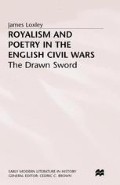Abstract
At the conclusion to his account of mid-seventeenth century cavalier verse, Earl Miner placed ‘the image of Izaak Walton and the younger Charles Cotton fishing in the Dove on a fine day’. It was, he averred, a picture that conveyed ‘something of those golden moments that have made Cavalier poetry appealing to so many and for so long’.1 In offering this epitome Miner gave clear outlines to the sometimes indistinct but always recognisable critical character that had long dominated discussion of such verse. Miner’s account envisages cavalier poetry as a literature of ‘golden moments’, a celebration of love, friendship and the good life of rural retirement. A poetics stretching from one end of the seventeenth century to the other is defined as an idiom skilled in transcending public disturbance through the more uplifting, private achievement of stoic or epicurean content.
Access this chapter
Tax calculation will be finalised at checkout
Purchases are for personal use only
Preview
Unable to display preview. Download preview PDF.
Notes
Earl Miner, The Cavalier Mode from Jonson to Cotton (Princeton, NJ: Princeton University Press, 1971), 306.
See, for example, Cyril Hughes Hartmann, The Cavalier Spirit and Its Influence on the Life and Work of Richard Lovelace (1618–1658) (London: George Routledge, 1925).
Kevin Sharpe, ‘Cavalier Critic? The Ethics and Politics of Thomas Carew’s Poetry’, in Derek Hirst and Steven Zwicker, eds, The Politics of Discourse (Berkeley, Los Angeles and London: University of California Press, 1987), 117–46
Sharpe, Criticism and Complement: The Politics of Literature in the England of Charles I (Cambridge: Cambridge University Press, 1987)
Thomas Corns, ‘Thomas Carew, Sir John Suckling and Richard Lovelace’, in Thomas Corns, ed., The Cambridge Companion to English Poetry, Donne to Marvell (Cambridge: Cambridge University Press, 1993), 200–20.
Gerald Hammond, ‘Richard Lovelace and the Uses of Obscurity’, Proceedings of the British Academy, 71 (1985), 203–34
Ann Baynes Coiro, Robert Herrick’s ‘Hesperides’ and the Epigram Book Tradition (Baltimore and London: Johns Hopkins University Press, 1988).
Lois Potter, Secret Rites and Secret Writing: Royalist Literature, 1641–1660 (Cambridge: Cambridge University Press, 1989)
Nigel Smith, Literature and Revolution in England, 1640–1660 (New Haven, CT and London: Yale University Press, 1994).
Abraham Wright, Parnassus Biceps, ed. Peter Beal (Aldershot: Scolar Press, 1990), ix.
See Erica Veevers, Images of Love and Religion: Queen Henrietta Maria and Court Entertainments (Cambridge: Cambridge University Press, 1989), 23–33.
Albert J. Loomie, ed., Ceremomies of Charles I: The Note Books of Sir John Einet, 1628–1641 (New York: Fordham University Press, 1987), 23–33.
Copyright information
© 1997 James Loxley
About this chapter
Cite this chapter
Loxley, J. (1997). Introduction: As Clearly Malignant as Cavalier. In: Royalism and Poetry in the English Civil Wars. Early Modern Literature in History. Palgrave Macmillan, London. https://doi.org/10.1057/9780230389199_1
Download citation
DOI: https://doi.org/10.1057/9780230389199_1
Publisher Name: Palgrave Macmillan, London
Print ISBN: 978-1-349-39798-3
Online ISBN: 978-0-230-38919-9
eBook Packages: Palgrave Literature & Performing Arts CollectionLiterature, Cultural and Media Studies (R0)

